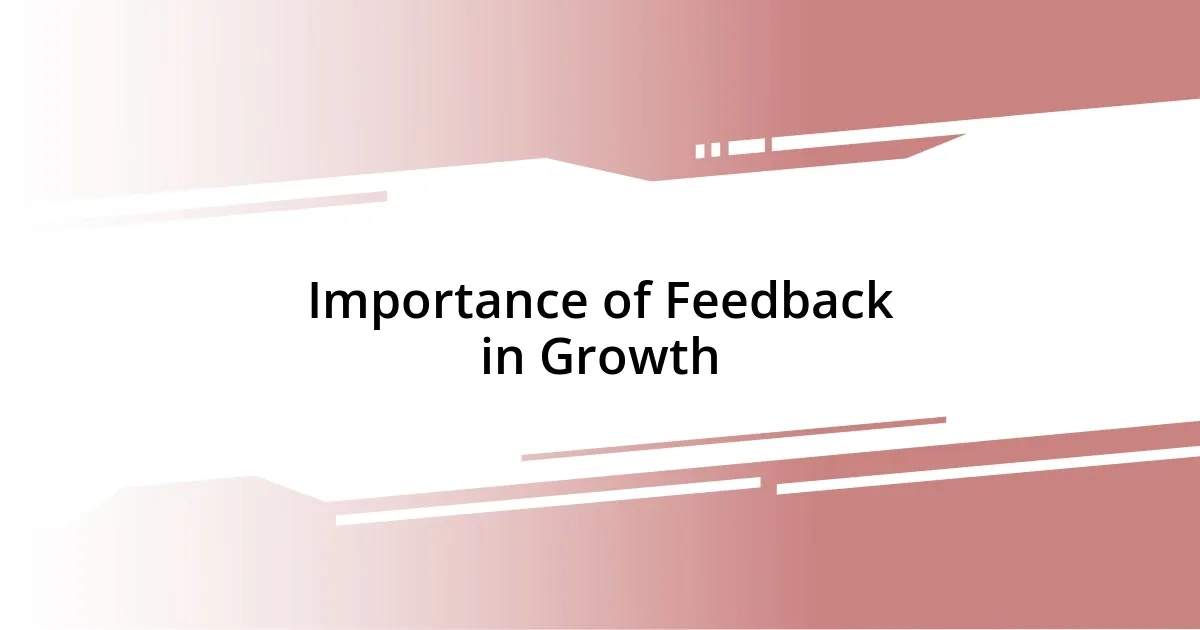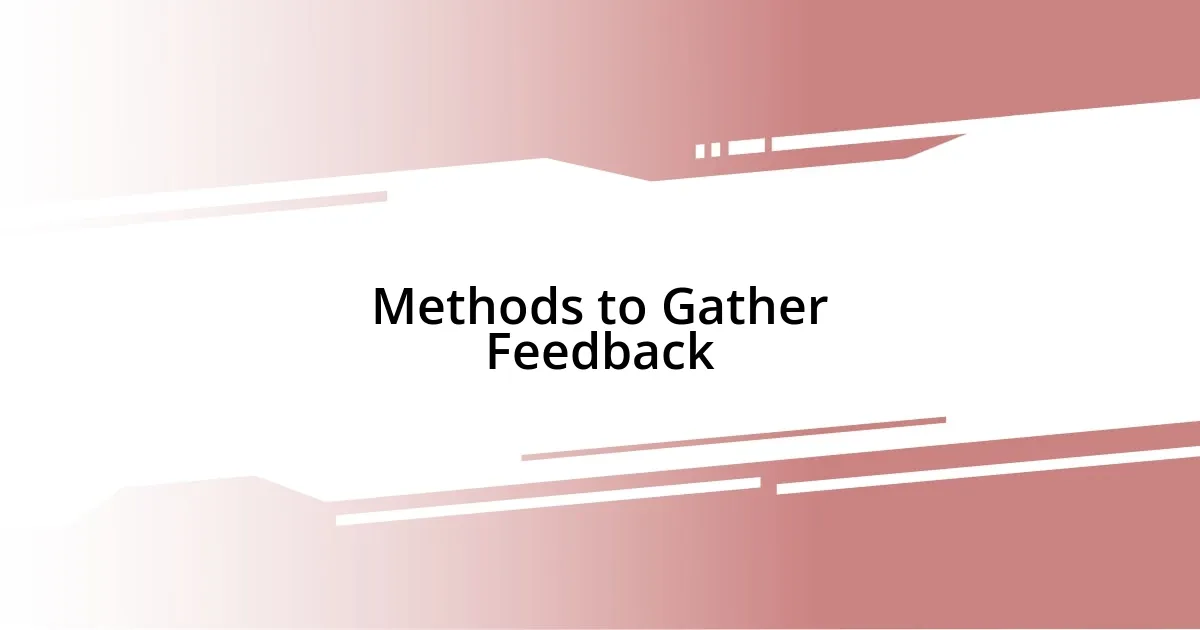Key takeaways:
- Feedback is a valuable tool for growth, shifting perspectives from defensiveness to curiosity.
- Incorporating feedback involves active listening, immediate application of suggestions, and maintaining a feedback loop for continuous improvement.
- Analyzing feedback helps identify patterns and blind spots, leading to enhanced self-awareness and communication skills.
- Tracking progress through measurable goals and visual aids reinforces commitment to personal development and growth.

Understanding Feedback in Reflection
Feedback is like a mirror reflecting our strengths and areas for growth. I remember receiving constructive criticism on a project that really stung at first. However, instead of brushing it off, I took a moment to reflect deeply on it, realizing that it was a valuable opportunity for improvement.
When I engage with feedback, I often find myself asking, “What can I learn from this?” This question shifts my perspective from defensiveness to curiosity. I recall a time when a colleague suggested a different approach to my presentation style. Initially, I felt disheartened, but as I pondered their viewpoint, I discovered new techniques that ultimately enhanced my confidence and delivery.
Moreover, feedback helps to pinpoint specific moments that deserve more reflection. For instance, I once received comments on my writing that highlighted a lack of clarity in certain sections. Diving back into those areas with an open mind allowed me not only to clarify my message but also to dig deeper into my motivations for writing in the first place. It made me realize that reflection isn’t just about reviewing what happened; it’s about understanding why and how those experiences shape my journey.

Importance of Feedback in Growth
Feedback serves as a crucial element for personal and professional growth. I’ve often found that when I receive feedback, it feels like a guiding light. It highlights areas that require my attention and fosters a desire to improve. There was a time when my supervisor pointed out my tendency to overlook detail in reports. While it stung initially, I dedicated myself to honing my attention to detail, and the transformation was rewarding.
The beauty of feedback lies in its ability to catalyze change. When I reflect on a piece of feedback, I strive to identify actionable steps that I can take. For example, during a team project, one teammate suggested I focus more on collaboration rather than taking the lead. This insight prompted me to adopt a more inclusive leadership style, which not only enriched our project but also fostered stronger team dynamics. I’ve learned that feedback is not merely criticism; it is a chance to reshape my approach.
I think of feedback as a bridge to self-discovery. Each time I receive it, I enter a new layer of understanding. There was a specific instance when a mentor told me that my enthusiasm often overshadowed my message. By reflecting on this feedback, I learned to balance my excitement with clarity, ultimately improving my communication skills. It became evident that feedback can reveal blind spots that we may not recognize ourselves.
| Aspect | Without Feedback | With Feedback |
|---|---|---|
| Self-Awareness | Limited understanding of strengths and weaknesses. | Enhanced insight into personal performance and growth areas. |
| Motivation | Stagnation or complacency. | Increased drive to improve and adapt. |
| Goal Setting | Vague or unclear objectives. | Specific, actionable goals based on feedback. |
| Collaboration | Isolation in the learning process. | Fosters a sense of community and shared growth. |

Methods to Gather Feedback
To effectively gather feedback, I often utilize a blend of formal and informal methods. For instance, one of my favorites is to create feedback forms after workshops or presentations. I’ve found that people appreciate having a structured way to share their thoughts. On the flip side, informal conversations over coffee tend to uncover more candid insights. These relaxed settings can lead to unexpectedly valuable perspectives.
Here are some effective methods I’ve used:
- Surveys and Questionnaires: Digital platforms allow for anonymous responses, encouraging honesty.
- One-on-One Meetings: Personal discussions can foster deeper understanding and clarity.
- Peer Reviews: Collaborating with colleagues can provide diverse viewpoints.
- Focus Groups: Gathering a small group encourages interactive discussions and immediate feedback.
- Check-in Sessions: Regular updates can track progress and solicit ongoing feedback.
I sometimes get surprised by the insights gathered from various channels. For example, early on, I hosted a casual feedback session after a team project, inviting everyone to share their thoughts while munching on snacks. The open atmosphere generated a wealth of feedback that wasn’t just insightful, but also deepened our team bond. I walked away feeling inspired, knowing that these informal channels can produce genuine and constructive perspectives.

Analyzing Feedback for Reflection
Analyzing feedback isn’t merely about gathering comments; it’s about understanding the underlying messages. I remember a time when a colleague critiqued my presentation style, suggesting I incorporate more storytelling elements. At first, I felt defensive, but then I realized that feedback often carries a goldmine of perspective. By dissecting those words, I could explore not only my strengths but also areas ripe for enhancement. Isn’t it fascinating how a few pieces of constructive feedback can spark a complete transformation?
When I reflect on feedback, I categorize the insights into themes. This strategy allows me to pinpoint recurring patterns in what others perceive. For example, in a recent feedback session, multiple peers mentioned my tendency to rush through complex topics. I was surprised to see this recurring theme surface from different corners of the room. Analyzing their feedback collectively, I recognized this as an opportunity to slow down and provide clarity, thus deepening my connection with my audience. Isn’t it intriguing when different voices harmonize to deliver a unified message?
Ultimately, I approach feedback analysis with curiosity and an open mind. After receiving constructive criticism, I always ask myself, “What can I learn from this?” During one review, a mentor pointed out that I often dive straight into solutions without first addressing the problem. This reflection nudged me to rethink my problem-solving approach, allowing for a more thoughtful and comprehensive discussion. It’s like uncovering a hidden gem; once you dig a little deeper, you realize there’s always more to discover about yourself and your process. What gems have you found in your own feedback experiences?

Techniques to Implement Feedback
Incorporating feedback effectively requires active listening and a willingness to adapt. Once, after receiving feedback from a team member about my project management style, I set up a “reflection circle.” Here, each team member shared their perspectives and suggestions, creating a safe space for honest dialogue. I found that this technique not only deepened our understanding of each other’s insights but also fostered a sense of team unity.
Another technique I’ve embraced is the practice of immediate application. After a feedback session, I challenge myself to implement at least one suggestion within a week. For example, when someone recommended that I improve my presentation visuals, I took it to heart and revamped my slides for the next project. This immediate action not only reinforced my commitment to growth but also demonstrated to my colleagues that I value their input.
I also recommend keeping a feedback journal. Writing down the feedback I receive helps me process it more deeply. I recall a time when I penned down comments from a workshop facilitator regarding my facilitation techniques. A few weeks later, I revisited those notes and noticed a clear theme of being too directive. Recognizing this pattern motivated me to shift my approach and become more of a guide in future sessions. How do you process and integrate the feedback you receive?

Tracking Progress over Time
Tracking my progress over time has become a vital part of my personal growth journey. I recall a period where I regularly revisited feedback from a project that didn’t go as planned. By looking back at the comments, I began to see not just what went wrong but also the small, consistent improvements I made along the way. Isn’t it powerful to witness your evolution through the lens of past evaluations?
One strategy that has worked well for me is setting specific, measurable goals based on the feedback I receive. For instance, after realizing I tended to dominate discussions in meetings, I decided to track my speaking time over a few weeks. Each time I reviewed my progress, I felt motivated to engage others more, and I could see how much more collaborative our discussions became. It’s amazing how data can illuminate personal growth, right?
I also find that visual aids can be really helpful in tracking progress. I created a simple graph to reflect my feedback themes and how I addressed them over time. For example, after identifying that I needed to work on my active listening skills, I recorded each instance where I consciously applied those techniques. Watching that chart evolve was not just satisfying; it reinforced my commitment to continuous improvement. Have you ever considered visualizing your progress to illustrate your growth?

Creating a Feedback Loop
Building a feedback loop is essential for continuous personal development. I remember a time when I decided to implement regular check-ins with colleagues after major projects. These discussions felt like a breath of fresh air, allowing us to share what worked, what didn’t, and most importantly, how we could improve together. Do you ever wonder how such small gatherings can lead to big changes?
One thing that became evident to me during these sessions was the power of vulnerability. I encouraged everyone to be open about their challenges, which paved the way for more constructive feedback. The first time I admitted I was struggling with time management, the understanding and support I received turned that vulnerability into a genuine bonding experience. Isn’t it remarkable how sharing our weaknesses can strengthen our relationships?
Another effective strategy I’ve adopted is following up on the feedback I’ve given and received. I often reach out weeks later to see how suggestions have been implemented and to offer further insights. One memorable instance was when a peer expressed uncertainty about a client presentation. A few months later, I followed up and learned she’d not only used my suggestions but had also landed a significant project. That moment reinforced the importance of maintaining that feedback loop—sometimes, it’s the continued connection that leads to lasting impact. Have you ever thought about how following up can amplify the results of feedback?














